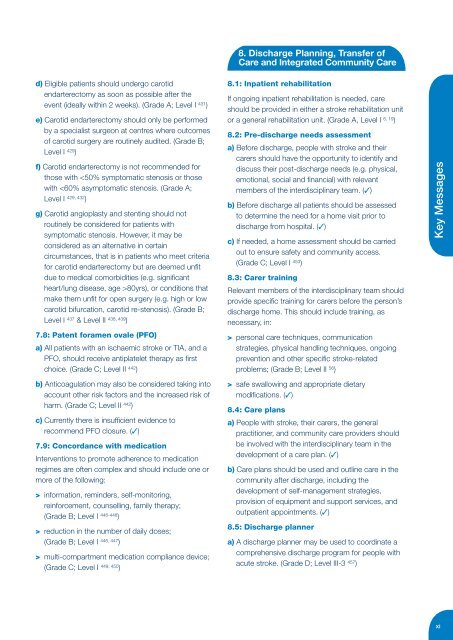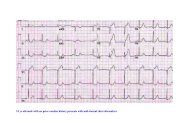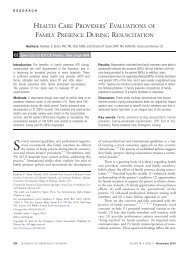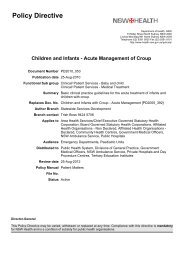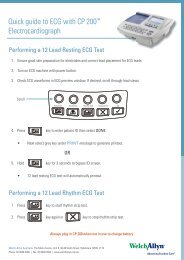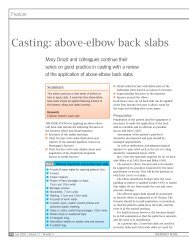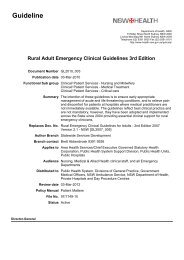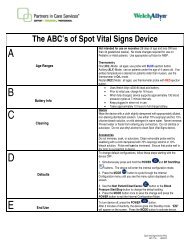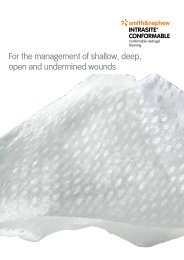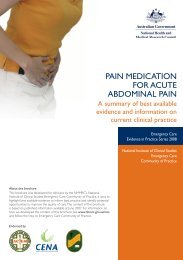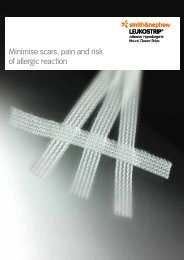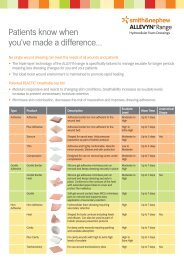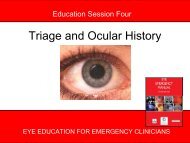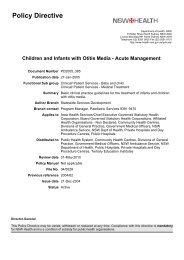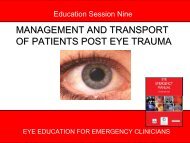Clinical Guidelines for Acute Stroke Management - Living on the EDge
Clinical Guidelines for Acute Stroke Management - Living on the EDge
Clinical Guidelines for Acute Stroke Management - Living on the EDge
Create successful ePaper yourself
Turn your PDF publications into a flip-book with our unique Google optimized e-Paper software.
8. Discharge Planning, Transfer of<br />
Care and Integrated Community Care<br />
d) Eligible patients should undergo carotid<br />
endarterectomy as so<strong>on</strong> as possible after <strong>the</strong><br />
event (ideally within 2 weeks). (Grade A; Level I 431 )<br />
e) Carotid endarterectomy should <strong>on</strong>ly be per<str<strong>on</strong>g>for</str<strong>on</strong>g>med<br />
by a specialist surge<strong>on</strong> at centres where outcomes<br />
of carotid surgery are routinely audited. (Grade B;<br />
Level I 429 )<br />
f) Carotid endarterectomy is not recommended <str<strong>on</strong>g>for</str<strong>on</strong>g><br />
those with in<str<strong>on</strong>g>for</str<strong>on</strong>g>mati<strong>on</strong>, reminders, self-m<strong>on</strong>itoring,<br />
rein<str<strong>on</strong>g>for</str<strong>on</strong>g>cement, counselling, family <strong>the</strong>rapy;<br />
(Grade B; Level I 446-448 )<br />
> reducti<strong>on</strong> in <strong>the</strong> number of daily doses;<br />
(Grade B; Level I 446, 447 )<br />
> multi-compartment medicati<strong>on</strong> compliance device;<br />
(Grade C; Level I 449, 450 )<br />
8.1: Inpatient rehabilitati<strong>on</strong><br />
If <strong>on</strong>going inpatient rehabilitati<strong>on</strong> is needed, care<br />
should be provided in ei<strong>the</strong>r a stroke rehabilitati<strong>on</strong> unit<br />
or a general rehabilitati<strong>on</strong> unit. (Grade A, Level I 6, 19 )<br />
8.2: Pre-discharge needs assessment<br />
a) Be<str<strong>on</strong>g>for</str<strong>on</strong>g>e discharge, people with stroke and <strong>the</strong>ir<br />
carers should have <strong>the</strong> opportunity to identify and<br />
discuss <strong>the</strong>ir post-discharge needs (e.g. physical,<br />
emoti<strong>on</strong>al, social and financial) with relevant<br />
members of <strong>the</strong> interdisciplinary team. (✓)<br />
b) Be<str<strong>on</strong>g>for</str<strong>on</strong>g>e discharge all patients should be assessed<br />
to determine <strong>the</strong> need <str<strong>on</strong>g>for</str<strong>on</strong>g> a home visit prior to<br />
discharge from hospital. (✓)<br />
c) If needed, a home assessment should be carried<br />
out to ensure safety and community access.<br />
(Grade C; Level I 453 )<br />
8.3: Carer training<br />
Relevant members of <strong>the</strong> interdisciplinary team should<br />
provide specific training <str<strong>on</strong>g>for</str<strong>on</strong>g> carers be<str<strong>on</strong>g>for</str<strong>on</strong>g>e <strong>the</strong> pers<strong>on</strong>’s<br />
discharge home. This should include training, as<br />
necessary, in:<br />
> pers<strong>on</strong>al care techniques, communicati<strong>on</strong><br />
strategies, physical handling techniques, <strong>on</strong>going<br />
preventi<strong>on</strong> and o<strong>the</strong>r specific stroke-related<br />
problems; (Grade B; Level II 56 )<br />
> safe swallowing and appropriate dietary<br />
modificati<strong>on</strong>s. (✓)<br />
8.4: Care plans<br />
a) People with stroke, <strong>the</strong>ir carers, <strong>the</strong> general<br />
practiti<strong>on</strong>er, and community care providers should<br />
be involved with <strong>the</strong> interdisciplinary team in <strong>the</strong><br />
development of a care plan. (✓)<br />
b) Care plans should be used and outline care in <strong>the</strong><br />
community after discharge, including <strong>the</strong><br />
development of self-management strategies,<br />
provisi<strong>on</strong> of equipment and support services, and<br />
outpatient appointments. (✓)<br />
8.5: Discharge planner<br />
a) A discharge planner may be used to coordinate a<br />
comprehensive discharge program <str<strong>on</strong>g>for</str<strong>on</strong>g> people with<br />
acute stroke. (Grade D; Level III-3 457 )<br />
Key Messages<br />
xi


